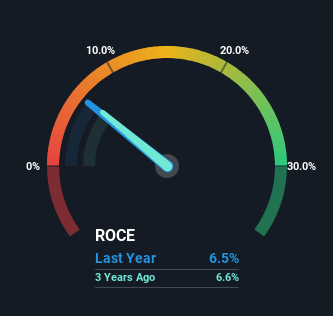Austevoll Seafood (OB:AUSS) Could Be Struggling To Allocate Capital

There are a few key trends to look for if we want to identify the next multi-bagger. Ideally, a business will show two trends; firstly a growing return on capital employed (ROCE) and secondly, an increasing amount of capital employed. Basically this means that a company has profitable initiatives that it can continue to reinvest in, which is a trait of a compounding machine. Although, when we looked at Austevoll Seafood (OB:AUSS), it didn't seem to tick all of these boxes.
Return On Capital Employed (ROCE): What Is It?
Just to clarify if you're unsure, ROCE is a metric for evaluating how much pre-tax income (in percentage terms) a company earns on the capital invested in its business. Analysts use this formula to calculate it for Austevoll Seafood:
Return on Capital Employed = Earnings Before Interest and Tax (EBIT) ÷ (Total Assets - Current Liabilities)
0.065 = kr2.8b ÷ (kr52b - kr8.6b) (Based on the trailing twelve months to September 2023).
Thus, Austevoll Seafood has an ROCE of 6.5%. In absolute terms, that's a low return but it's around the Food industry average of 7.7%.
See our latest analysis for Austevoll Seafood

Above you can see how the current ROCE for Austevoll Seafood compares to its prior returns on capital, but there's only so much you can tell from the past. If you'd like to see what analysts are forecasting going forward, you should check out our free report for Austevoll Seafood.
What The Trend Of ROCE Can Tell Us
On the surface, the trend of ROCE at Austevoll Seafood doesn't inspire confidence. Over the last five years, returns on capital have decreased to 6.5% from 14% five years ago. However it looks like Austevoll Seafood might be reinvesting for long term growth because while capital employed has increased, the company's sales haven't changed much in the last 12 months. It may take some time before the company starts to see any change in earnings from these investments.
The Key Takeaway
Bringing it all together, while we're somewhat encouraged by Austevoll Seafood's reinvestment in its own business, we're aware that returns are shrinking. And in the last five years, the stock has given away 21% so the market doesn't look too hopeful on these trends strengthening any time soon. In any case, the stock doesn't have these traits of a multi-bagger discussed above, so if that's what you're looking for, we think you'd have more luck elsewhere.
On a final note, we found 2 warning signs for Austevoll Seafood (1 makes us a bit uncomfortable) you should be aware of.
For those who like to invest in solid companies, check out this free list of companies with solid balance sheets and high returns on equity.
New: Manage All Your Stock Portfolios in One Place
We've created the ultimate portfolio companion for stock investors, and it's free.
• Connect an unlimited number of Portfolios and see your total in one currency
• Be alerted to new Warning Signs or Risks via email or mobile
• Track the Fair Value of your stocks
Have feedback on this article? Concerned about the content? Get in touch with us directly. Alternatively, email editorial-team (at) simplywallst.com.
This article by Simply Wall St is general in nature. We provide commentary based on historical data and analyst forecasts only using an unbiased methodology and our articles are not intended to be financial advice. It does not constitute a recommendation to buy or sell any stock, and does not take account of your objectives, or your financial situation. We aim to bring you long-term focused analysis driven by fundamental data. Note that our analysis may not factor in the latest price-sensitive company announcements or qualitative material. Simply Wall St has no position in any stocks mentioned.
About OB:AUSS
Austevoll Seafood
A seafood company, produces salmon and trout, whitefish, and pelagic in Norway, the European Union, the United Kingdom, Eastern Europe, Africa, North America, Asia, and South America.
Very undervalued with excellent balance sheet.
Similar Companies
Market Insights
Community Narratives




